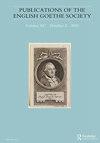咀嚼:歌德的《普罗塞菲娜》
IF 0.1
3区 文学
0 LITERATURE, GERMAN, DUTCH, SCANDINAVIAN
引用次数: 1
摘要
摘要本文认为,歌德将普罗塞佩娜丰富的神话简化为一系列纯粹的重复,这些重复以各种形式支配着整部戏剧。歌德把神话再现为一个修辞的骨架,或者更确切地说,是修辞的骨架。换句话说,歌德的《普罗塞佩娜》进行了一次元戏剧实验,利用重复提供的丰富的语言可能性,是一部以重复为真正女主角的独角戏。本文章由计算机程序翻译,如有差异,请以英文原文为准。
Chewing: Goethe’s Proserpina
Abstract This article argues that Goethe reduced the rich myth of Proserpina to a sequence of pure repetitions, which in their various forms then dominate the entire text of the drama. Goethe reproduces the myth as a rhetorical skeleton or, rather, as the skeleton of rhetoric. Put differently, Goethe’s Proserpina, executing a meta-theatrical experiment with the rich linguistic possibilities repetition provides, is a monodrama whose actual heroine is repetition.
求助全文
通过发布文献求助,成功后即可免费获取论文全文。
去求助
来源期刊

Publications of the English Goethe Society
LITERATURE, GERMAN, DUTCH, SCANDINAVIAN-
CiteScore
0.10
自引率
0.00%
发文量
15
 求助内容:
求助内容: 应助结果提醒方式:
应助结果提醒方式:


